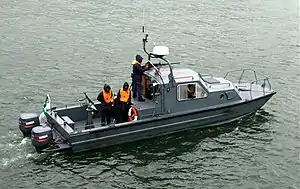Namacurra-class patrol boat
The Namacurra-class patrol boats are a series of small harbour patrol boats currently in service with South Africa, Namibia, Malawi and Mozambique.
 Namacurra-class patrol boats | |
| Class overview | |
|---|---|
| Builders | Tornado Products, South Africa |
| Operators |
|
| Built | 1980–1981 |
| In commission | 1980–present |
| Planned | 33 |
| Completed | 33 |
| Active | 32 |
| Lost | 1 |
| General characteristics | |
| Class and type | Harbour patrol craft |
| Displacement | |
| Length | 9.5 m (31 ft 2 in) |
| Beam | 2.7 m (8 ft 10 in) |
| Draught | 0.8 m (2 ft 7 in) |
| Propulsion | 2 × 280 kW (380 bhp) gasoline engines |
| Speed | 30 knots (56 km/h; 35 mph) |
| Range | 180 nmi (330 km; 210 mi) at 20 knots (37 km/h; 23 mph) |
| Complement | 4 |
| Sensors and processing systems | Surface search: Furuno I-band |
| Armament |
|
Background and description
The Namacurra class[2] (also spelled "Namicurra")[3] is a series of small harbour patrol craft designed and built in South Africa. Their catamaran-type hulls are made of glass-reinforced plastic. They have a displacement of 4 tonnes (3.9 long tons) light and 5.2 t (5.1 long tons) fully loaded and measure 9.5 metres (31 ft 2 in) with a beam of 2.7 m (8 ft 10 in) and a draught of 0.8 m (2 ft 7 in). The boats are powered by two BMW or Yamaha 280-kilowatt (380 bhp) gasoline engines turning two propellers giving the vessels a maximum speed of 30 knots (56 km/h; 35 mph) With a crew of four they have a maximum range of 180 nautical miles (330 km; 210 mi) at 20 knots (37 km/h; 23 mph).[3]
The patrol boats mount a Furuno surface search radar operating on the I band. They are armed with a 12.7-millimetre (0.50 in) machine gun or two 7.62 mm (0.30 in) light machine guns.[1] When fitted the 12.7 mm gun is placed atop the pilothouse facing forward and the 7.62 mm guns are mounted facing aft.[3] Their small size allows the vessels to be transported by trailers and transported by road.[2]
Construction and career
33 patrol boats were built in South Africa between 1980 and 1981 for service with the South African Navy. They were initially numbered beginning with Y 1500, but they were later renamed in South African service beginning keeping only the final two digits of their initial names, beginning with Y 02.[2][3] These boats are in use with the harbour patrol forces in Cape Town, Port Elizabeth, Durban and Walvis Bay.[2] Y 1506 was lost at sea off Port Elizabeth.[4] Several boats were transferred to other nations. Five were refitted for advanced riverine operations as part of Project Xena.[3] Three were operated on Lake Tanganyika.[2]
Export
Y 1520 transferred to Malawi in October 1988. The vessel was renamed Kaning'a. Kaning'a was refitted in 2007. A second boat was transferred in October 2008.[2][5] Two, Y 1501 and Y 1510 were transferred to Namibia on 29 October 2002. They were renamed Y 01 and Y 10 respectively.[6] Y 1507 and Y 1530 were donated to Mozambique on 14 September 2004 They too were renamed to Y 07 and Y 30.[7] In 2006, a further two were donated to Angola.[2][3]
Citations
- Du Toit 1992, p. 295.
- Saunders 2009, p. 737.
- Wertheim 2013, pp. 666–667.
- Du Toit 1992, p. 296.
- Wertheim 2013, pp. 431–432.
- Wertheim 2013, p. 472.
- Wertheim 2013, p. 467.
References
- Du Toit, Allan (1992). South Africa's Fighting Ships: Past and Present. Ashanti.
- Saunders, Stephen, ed. (2009). Jane's Fighting Ships 2009–2010 (112 ed.). Alexandria, Virginia: Jane's Information Group Inc. ISBN 0-7106-2888-9.
- Wertheim, Eric, ed. (2013). The Naval Institute Guide to Combat Fleets of the World (16th ed.). Annapolis, Maryland: Naval Institute Press. ISBN 9-7-815911-4954-5.